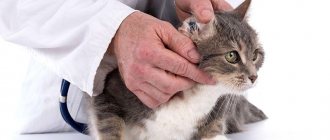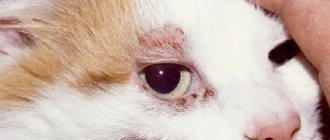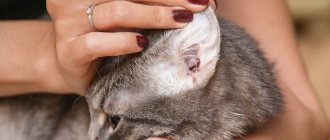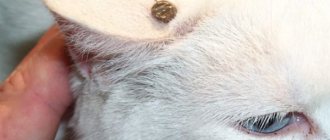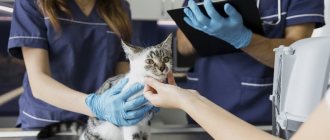Otodectes cynotis is a parasitic disease. The causative agent is an ear mite that is difficult to see with the naked eye. Ear scabies are a fairly common disease among domestic and wild cats. This parasite lives and parasitizes on the surface of the skin, especially in the area of the ears, penetrates the ear canal, actively multiplies and can even reach the eardrum. In advanced cases, the pathogen reaches the brain and invades it, causing severe inflammation and destruction of the brain. The mite feeds on dead and living epithelial cells of the skin of the auricle and external auditory canal; the parasite develops quickly. The life cycle of the parasite usually takes 3-4 weeks. In the external environment or on the body of an animal, a tick can live up to 25 days.
Causes of otodectosis in cats
Feline ear mites are a highly contagious (highly contagious) disease. Otodectosis can affect not only cats, but also dogs, arctic foxes, foxes and even rodents. Ticks are transmitted from cats to kittens and from kittens to kittens. An adult cat can also become infected with ear scabies during mating. Often, infection occurs without direct contact with an infected animal, but through contact with surfaces where ticks and/or parasite eggs can be released from the skin or ear of an infected animal.
Ear mites in a cat
Because Cat mites can cause severe itching, the animal experiences constant discomfort on the surface of the skin, shakes its ears, the causative agent of otodectosis is “shaken out” into the environment and this further contributes to the transmission of ear mites to other animals.
Healthy animal ear
Otodectosis in a cat
Otodectosis (ear mites)
Over the course of their lives, pets are susceptible to many different parasitic infestations.
Fleas, lice eaters, worms, forest ticks (sources of piroplasmosis in dogs). One of the parasites is Otodectes cynotis, or in everyday life ear mites, ear scabies. In this article we will look at what to look for, how the diagnosis is made and, most importantly, how to protect your pet from infection with this parasite.
Symptoms of otodectosis in cats
The disease is more common in young animals. The main symptom of the disease is excessive release of earwax from the external auditory canal - a wet or dry crust has the appearance and color of ground coffee, a large amount of plaque can even completely clog the ear canal. Inflammation of the surface of the external auditory canal can have manifestations of varying degrees of severity - from heavy discharge with minimal or no itching to slight discharge with severe itching, or even be practically asymptomatic.
The mites come out of the ear canal, especially when the cat is curled up, the mites can spread to the neck, thighs, tail, etc. The skin at the site of parasites can be damaged due to scratching. A common symptom with such a spread of parasites is dermatitis, alopecia (bald patches), etc.
An advanced disease with a complicated form of inflammation goes deeper and deeper and after the tympanic membrane ruptures, the process spreads to the inner ear, then to the meninges. Here the symptoms become more serious: lethargy, increased local temperature, and then increased body temperature, tilting the head to the affected side, and various phenomena of neurological symptoms - seizures, convulsions, etc.
Symptoms of ear mites
- Itching in the ears and in the area between the eyes and ears.
- ·Specific dark-colored discharge.
- Scratching and sores on the ears
- Hair loss (as a result of constant mechanical stress)
- Head shaking
- Unpleasant odor from the ear canal
- · In severe cases, swelling of the ear canal and auricle.
Most often, the first signs of concern, according to the owners, are that the cat or dog “shakes its ears or head” and the constant secretion of secretion “the ears quickly get dirty.”
Tick of the genus Otodectes cynotis
under a microscope
Diagnosis of otodectosis in cats
It is impossible to make a diagnosis on your own, since the disease has similar symptoms to many infections. Diagnosis should only be carried out by a veterinarian, and since... the disease is often complicated by the addition of secondary microflora; it is not always possible to quickly make an accurate diagnosis. If the disease is neglected, serious complications can develop, which can lead to disability or even death of the animal!
To make a diagnosis, the veterinarian collects anamnesis and clinical signs.
The doctor carefully examines the animal’s ear, pays attention to dry crusts, purulent wounds, takes a scraping and conducts a microscopic examination of the earwax. Under a microscope, live mites, their larvae and eggs are visible. Such a study allows you to make an accurate diagnosis. Damage to the auricle can also be of microbial or fungal origin. In case of a complicated form of the disease, a cytological examination is performed, this makes it possible to detect accompanying microflora (bacteria and fungal flora). Sometimes it is necessary to do a bacterial culture and titrate antibiotics, especially if the owners have already treated their pet on their own.
If necessary, otoscopy is performed - this is an instrumental method of examining the surface of the eardrum and external auditory canal using a special device (otoscope), but if the auricle is severely inflamed, then this procedure is postponed until the condition has stabilized.
If there are lesions on the surface of the animal’s body, then a scraping is taken not only from the auricle, but also from the skin and microscopy is performed (examination of the material using a microscope).
Diagnosis of the disease
Based on the above signs, it is not always possible to recognize otodectosis, and in such cases professional diagnosis is required. Some also perform a simple test at home, which is quite effective, but not always accurate. It is necessary to select discharge from the diseased ear and warm it on the surface of black paper. If moving light dots appear, these are ticks. In any case, the final diagnosis must be made by a doctor.
In laboratory conditions, diagnosing the disease comes down to searching for mites in scrapings from the affected surface under a microscope. At the same time, parasites can migrate, so they are not always detected on the first try. Before going to the clinic, you should not clean your animal’s ears for several days - this will increase the likelihood of recognizing the disease.
The tasks of the veterinarians at our clinic in Northern Medvedkovo often include excluding diseases that have symptoms similar to otodectosis:
- Notoedrosis, also known as sarcoptic mange. When ear mites appear, only the inner surfaces of the ears are affected. At the same time, otodectoses do not allow their fellows to enter the captured territory, so the subcutaneous mites of other colonies are located on the outside of the ear or on the face.
- Otitis externa. It may have a non-parasitic etiology, arising due to the frequent use of insectoacaricidal drugs to prevent ticks and fleas in the animal.
- Flea dermatitis, in which the entire ear begins to itch, with the exception of the inner surfaces of the shell.
- Malasseziasis – This disease is caused by a yeast that affects not only the ears, but also the areas surrounding the nose and eyes.
- Allergy, which is characterized by skin rashes around the eyes and mouth.
When it is not possible to determine the exact cause of inflammation, diagnosis is used by treatment: if after acaricidal drugs the symptoms are weakened, the cause is definitely in otodectosis.
Treatment of otodectosis in cats
Treatment is outpatient. Most often, diet and restriction of the animal’s activity are not required, except in the case when the vestibular (inner) ear apparatus has already been affected and surgical intervention is necessary.
Treatment consists of the main points:
- relieving inflammation (in case of infection with secondary flora during complicated otodectosis), alleviating itching and pain;
- cleansing (but only after acute inflammation has resolved);
- use of acaricidal drugs;
- prevention of re-infection and spread of the pathogen.
The disease is highly contagious (highly contagious), therefore, all cats and dogs that have contact with sick animals must be thoroughly treated with antiparasitic agents; habitats and bedding are also treated, because untreated litter can be a source of re-infestation.
The doctor prescribes a treatment for this pathogen, depending on the animal’s lifestyle (home or outdoor), how many animals have contact with the sick cat, the degree of inflammation and concomitant diseases. The drug can be in the form of drops, ointments, suspensions, sprays, powder and even injections and tablets. If the disease is chronic and there are symptoms of damage to the vestibular apparatus and/or brain, it is necessary to conduct a CT scan (computed tomography) to determine the extent of the damage, this will help prescribe adequate therapy.
In all forms of otodectosis, anti-mite treatment of the ears and body should be used.
Be careful when handling, as even a drop of some products can lead to serious poisoning.
If your pet experiences severe itching and injures the ears, then it is necessary to wear a protective collar. Most often, this advanced form of the disease requires the use of painkillers and anti-inflammatory drugs to relieve symptoms and speed up recovery.
The key to a quick recovery from parasitic otitis media is thorough and regular cleaning of the ears with lotions and the use of local anti-tick medications prescribed by a veterinarian. But ear cleaning must be done delicately so as not to damage the tympanic apparatus (eardrum). The item where the products used after cleaning the ears (cotton swabs, cotton wool, etc.) are placed must be carefully processed or placed in a sealed bag and disposed of after cleaning to prevent re-infection.
Treatment for ear mites is always long-term and takes from 28 days to several months.
Otodectosis is a common disease in cats that is caused by the Otodektos cynotis mite. These mites parasitize on the surface of the skin, most often in the ear area; they feed on skin cells, lay eggs there and reproduce. The activity of this mite causes excessive discomfort to cats and damages the ear canal. If treatment for otodectosis is not started in time, mites can cause complications of the disease. The main danger of ear scabies is putrefactive deposits secreted by mites, which can cause putrefactive otitis media.
Many animals are susceptible to otodectosis, including cats. Otodectosis is transmitted from cat to offspring. Interspecies transmission is also possible, for example from cat to dog. This disease is not dangerous for people, since they do not get it from animals.
Pathogen
The scabies mite is a tiny parasite measuring 0.45 mm. Accordingly, it is almost impossible to identify it with the naked eye. The tick has a tortoiseshell-shaped oval body, and instead of forelimbs it has claws. The structure of its mouthparts allows it to tear off pieces of the victim's skin. An ear mite can only move in one direction because its back is covered with scales that point in one direction. The parasite makes passages inside the skin, along which it moves and lays eggs in them. The life cycle of the scabies mite is about 30 days. During this time, the males fertilize the females; they, in turn, manage to lay several eggs in the tunnels. Ear mites are always actively moving, especially at night, this causes a lot of trouble for the animal. The tick feels most comfortable in conditions of high temperature and humidity; at temperatures below zero, it dies in just a couple of days.
Sources of infection and pathogenesis
A cat can bring a tick and, as a result, get sick with otodectosis in the following cases:
- Infected by another, sick animal. Moreover, it does not have to be a cat, since scabies mites can also be found on other animals. This is the most common cause of otodectosis. Of course, letting animals go for a walk is not recommended for many reasons, but if you do this, then carefully examine the cat after each outing.
- Tick eggs may end up on the pet owner's clothing. For example, if a person walked on the ground, and a sick dog or cat was scratching on it, eggs can get on shoes or pants. Or if the owner of the animal was visiting, and a sick cat rubbed against his clothes.
Once a cat is infected with otodectosis, mite waste will appear in its ear canal. When this waste ends up in wounds from parasite bites, very severe itching appears, and the animal begins to scratch itself, often until it bleeds. If treatment is not started in a timely manner, there is a risk of developing otitis media in the inner area of the ear. And in the most advanced cases, parasites can enter the brain, which can lead to the appearance of purulent meningitis. Its treatment is much more complex. Therefore, we advise you not to delay treatment of otodectosis. Ticks are the most dangerous for a kitten. Their immune system is still very weak, so they suffer great harm, which means the threat of otodectosis and, in the worst case, death increases significantly.
For humans, these parasites are not a strong threat, since ear mites cannot live on the human body. But they can provoke the appearance of pseudo-scabies - manifestations of an allergy to bites. The person does not need treatment, since the problem will disappear on its own when the cat is cured.
Symptoms of otodectosis
Otodectosis most often occurs in young cats. The main symptom of the disease is excessive secretion of wax from the external ear canal. It has a dry or wet crust that looks like ground coffee in color and consistency. If there is too much of it, sulfur can even completely block the ear canal. Inflammation of the outer ear canal can be difficult to diagnose because it can occur with few visible symptoms. But more often, large discharge appears with no or very minimal itching, or the discharge is insignificant, but the itching is severe.
Ear mites most often come out when the cat is lying in a ball shape. They can spread over the neck, body, and tail. In the place where parasites accumulate, the code is damaged due to the fact that the cat actively scratches it. Also common symptoms of otodectosis include receding hairline (alopecia) and dermatitis. If the disease is as advanced as possible, then the inflammation goes deeper and deeper. When the eardrum ruptures, inflammation spreads to the inner ear and then to the lining of the brain. In this case, more noticeable and serious symptoms are observed: lethargy, increased temperature (first local, and then body), the animal’s head is tilted towards the injured side, neurological symptoms are evident: convulsions and seizures.
Treatment of otodectosis
If you find ear mites in a cat, treatment should be timely and comprehensive. Most often, it is not necessary to impose any activity or diet restrictions on the animal, with the exception of damage to the vestibular apparatus. In this case, the cat needs surgery.
Treatment of otodectosis is carried out according to the following algorithm:
- Elimination of inflammation (if the cat has become infected with secondary flora in a complicated form of otodectosis), relieving pain and itching.
- Cleansing, prescribing acaricidal drugs, preventing re-infection and spread of the pathogen.
The disease is very contagious for animals, so those animals that have been in contact with the infected need to be treated with anti-parasite agents and their bedding treated, since they can also be a source of re-infection.
For any form of the disease, anti-tick treatment must be carried out. Treatment should be carried out very carefully, since even a small amount of some products can cause poisoning to the pet.
The most effective ear drops against ticks include Aurican. This is a complex remedy that has antiseptic, anti-inflammatory, bacteriostatic, bactericidal, insecticidal and local anesthetic effects. Place 5-20 drops into each ear of a sick animal (the amount depends on the size of the cat). You need to drip once a day for 7 days, then once a day 2 times a week for a month. The drug should not be used if the animal has a perforated eardrum and is hypersensitive to the components of the drops.
Ordermil ointment helps well in the treatment of otodectosis. It will help the animal maintain its hearing and neutralize ear infections. Before applying the ointment, it is necessary to clean the ear canal and sink with cotton wool and Vaseline oil, this will enhance the effect of the treatment. Next, apply a drop of ointment into the ear canal and distribute it in the ear, massaging it and thereby warming it up. If your pet has one ear affected, the ointment still needs to be applied to both. Repeat the procedure 2 times a day for 7-12 days.
If otodectosis has caused severe itching in your cat and it damages its ears while scratching, you need to put a protective collar on the cat. In most cases, such an advanced form of otodectosis requires the use of anti-inflammatory and painkillers.
To speed up recovery, we recommend cleaning your animal’s ears with lotions. Please note that lotions can only be used if the integrity of the eardrum is not damaged. You need to clean your cat's ears as carefully as possible so that it doesn't hurt it. Tools for cleaning ears (cotton wool, cotton swabs) should be placed in a sealed bag and disposed of immediately after the procedure is completed in order to prevent re-infection.
Epi-otik, Otifri, and Global vet lotions have proven themselves well. They maintain the health of the animal’s ears, successfully help get rid of unpleasant odor from the ears and old ear crusts, and have a beneficial effect on the microflora of the ear. Lotions soothe the skin and relieve itching. They can be applied before using medications. These lotions can be used 2-3 times a day until the symptoms disappear completely. You can then use it up to 2 times a week to maintain ear hygiene.
Effective means in the fight against otodectosis are drops on the withers. Stronghold antiparasitic drops actively fight ticks that parasitize cats and dogs. The drug has ovicidal and larvicidal properties, and has acaricidal and nematicidal effects. The great advantage of Stronghold is that it remains in the tissues and organs of the animal for a long time, thereby destroying parasites and providing protection against reinfestation for a month. The drug component selamectin interacts with the receptors of parasite cells, increasing the sensitivity of membranes to chlorine ions, thereby blocking the muscle and nerve cells of the parasites, which leads to paralysis and subsequent death. Stronghold is well tolerated by animals of different breeds.
Solution Advocate has a wide range of actions to combat parasites in animals. The solution is applied once to the intact dry skin of the animal, the volume is calculated based on the weight of the cat. If necessary, the course of treatment should be repeated after a month. Advocate should not be applied to damaged or damp skin. It is prohibited to wash the animal for 4 days after application, and it should not be used simultaneously with medications that contain macrocyclic lactones. After using Advocate, you do not need to pet the animal in the application areas and do not allow it near children for 24 hours.
Prevention of otodectosis
Without proper treatment, serious complications of otodectosis can develop, such as hearing loss (partial or complete) and even death if the brain is affected. Such complications, fortunately, are quite rare, but nevertheless it is necessary to take proper preventive measures to the maximum.
The most reliable preventive measure is treating the animal with anti-tick products, constantly examining the cat's ears, and in case of the slightest suspicion, immediately contacting a veterinarian. Regular cleaning of the cat's premises and bedding will help reduce the risk of infection. If the cat walks freely on the street, then treatments with sprays or drops on the withers should be carried out at least once a month. Remember that the attentive and responsible attitude of the owner is the key to the health of the pet!
Prevention of otodectosis in cats
Otodectosis can cause serious complications, including complete or partial hearing loss and death (if the brain is damaged). Fortunately, such complications are rare, but they do occur.
The most reliable prevention is regular treatment of cats with anti-tick agents, often included in flea products, regular examination of the pet's ears and timely contact with a veterinarian. Regular mechanical cleaning of premises, animal bedding, as well as treating the house with insecticidal agents help to significantly reduce the likelihood of infection with otodectosis and other infectious diseases.
If the animal has access to the street, preventive treatments with drops on the withers or sprays should be done once a month.



